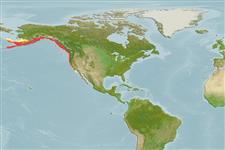Environment: milieu / climate zone / depth range / distribution range
Ecologie
marien demersaal; diepte 18 - 425 m (Ref. 6793). Temperate
Northeast Pacific: Bristol Bay, Alaska to Unimak Island in the Aleutian chain and Point Montara, California, USA (Ref. 6793); extended to southeastern Bering Sea (Ref. 51659).
Grootte / Gewicht / Leeftijd
Maturity: Lm ? range ? - ? cm
Max length : 20.0 cm TL mannelijk / geslacht onbekend; (Ref. 2850)
Dorsale stekels (totaal): 8 - 9; Dorsale zachte stralen (totaal): 6-9; Anale stekels 0; Anale zachte stralen: 10 - 12; Wervels: 35 - 37. Dorsal fins touching or nearly so; caudal rounded; anal long based and rather low; pectorals broad, lower 4 to 6 rays thickened and not joined by membrane as far as their ends; pelvic fins reduced (in males, long pelvic fins reaching as far as the origin of the anal fin) (Ref. 6885). Dark gray or brown on upper surface, paler beneath, the line of demarcation very clear on head; some individuals with 6 or more dark saddle-shaped markings over back and extending on sides; dorsal fins with dark bands following free margins on fins; longitudinal dark coloring follows rays of caudal fin, especially at distal ends; rows of dark spots on rays of pectorals, and a bright orange spot in its center; dark spots on eyeballs more abundant on upper part (Ref. 6885).
Found on soft bottoms (Ref. 2850).
Levenscyclus en paargedrag
Maturiteit | Voortplanting | Paaien | Eieren | Fecunditeit | Larven
Eschmeyer, W.N., E.S. Herald and H. Hammann, 1983. A field guide to Pacific coast fishes of North America. Boston (MA, USA): Houghton Mifflin Company. xii+336 p. (Ref. 2850)
Status op de Rode Lijst van het IUCN (Ref. 130435)
Gevaar voor de mens
Harmless
Gebruik door de mens
Meer informatie
Lokale namenSynoniemenMetabolismePredatorenEcotoxicologieVoortplantingMaturiteitPaaienPaaiaggregatiesFecunditeitEierenOntwikkeling van de eieren
ReferentiesAquacultuurAquacultuurprofielKweeklijnenGeneticaElectrophoresesErfelijkheidZiektesVerwerkingNutrientsMassaconversie
Tools
Speciale rapporten
Download XML
Internetbronnen
Estimates based on models
Preferred temperature (Ref.
123201): 2.9 - 8.6, mean 5.3 °C (based on 283 cells).
Fylogenetische diversiteitsindex (Ref.
82804): PD
50 = 1.0000 [Uniqueness, from 0.5 = low to 2.0 = high].
Bayesian length-weight: a=0.00389 (0.00180 - 0.00842), b=3.12 (2.94 - 3.30), in cm total length, based on all LWR estimates for this body shape (Ref.
93245).
Trofisch niveau (Ref.
69278): 3.2 ±0.3 se; based on size and trophs of closest relatives
Weerstandsvermogen (Ref.
120179): Gemiddeld, minimale populatieverdubbelingstijd 1,4-4,4 jaar (Preliminary K or Fecundity.).
Fishing Vulnerability (Ref.
59153): Low vulnerability (10 of 100).
